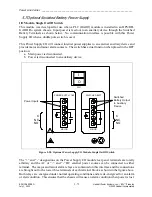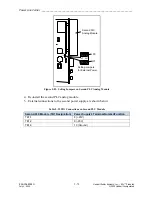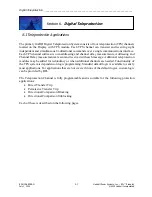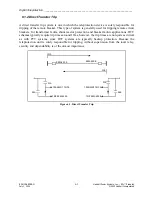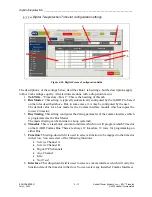
Digital Teleprotection __________________________________________________________________
RF-MCGARDPRO
Hubbell Power Systems, Inc.
–
RFL™
Products
July 1, 2022
©2022 Hubbell Incorporated
6-11
Timeslot configuration rules
The rules which determine other behaviors of these tabs and the options available in the
drop-downs for both function and interface are defined below.
Note
: The rules will be more comprehensible after going through this whole section.
Clock and Bus Master/Slave, Internal/Loop
•
If only one interface is programmed on a Bus, then that interface is the “Bus Master”. Its
“Timing” is set to “Internal” or “Loop”, selected by the user. Default is Internal.
•
If more than one interface is programmed on a Bus, the Bus Master may be selected (the
Bus Master field is active/programmable).
DEFAULT: The module which occupies the lowest # timeslot is the default Bus Master.
For example, if you select G.703 on TS2 and then select C37.94 on TS1, C37.94 is the
Master.
•
If an interface is programmed on a Bus (occupying at least one timeslot on the Bus), but
is not the Bus Master, it is programmed as a “Slave”. When this is the case, its timing is
always derived from the bus and the bus master.
Framing
•
For RS-449/X.21/V.35, C37.94, and Long-Haul Fiber: Framing is ENABLED on an
interface if more than one timeslot is used on that interface.
•
Framing adds one 64k timeslot on an interface. Therefore, the maximum number of
functions that can be mapped over a C37.94 interface is 11 (11 fun 1 framing =
12 timeslots = 768k). The other interfaces can go to 13x64kbps
•
If a Service Channel is enabled over an interface, that interface has framing ENABLED
automatically, regardless of how many timeslots it occupies.
T1/E1 Specifics
•
A T1/E1 module occupies ALL timeslots on the bus. If a T1/E1 module is selected for
any timeslot, all other timeslots become “comms interface” = T1/E1. Also, any unused
“function” timeslots are automatically set to “Idle”.
•
If another module is already occupying a timeslot on a Bus, and a T1/E1 module is
selected as the interface on another timeslot, it will “kick out” the other module, and all
timeslot interface will be populated with T1/E1.
•
If a T1/E1 module is already occupying a Bus, and another module like C37.94 is
selected as the interface on a timeslot on that Bus, it will “kick out” the T1/E1 module
from all other timeslots on that Bus.
•
If the T1/E1 is selected as the bus interface, and there are two T1/E1 modules installed
in the chassis, and both are programmed as “Drop-and-Insert”, then the option in the
Function drop-down called “Not Used” is re-named “Pass-Thru”.
General
•
If a function is selected for a timeslot, it is no longer available in the other Function
drop-down lists, on either tab. If the function is selected on TS1 Bus 1 then it is not
available on any other timeslot on Bus 1 or Bus 2

